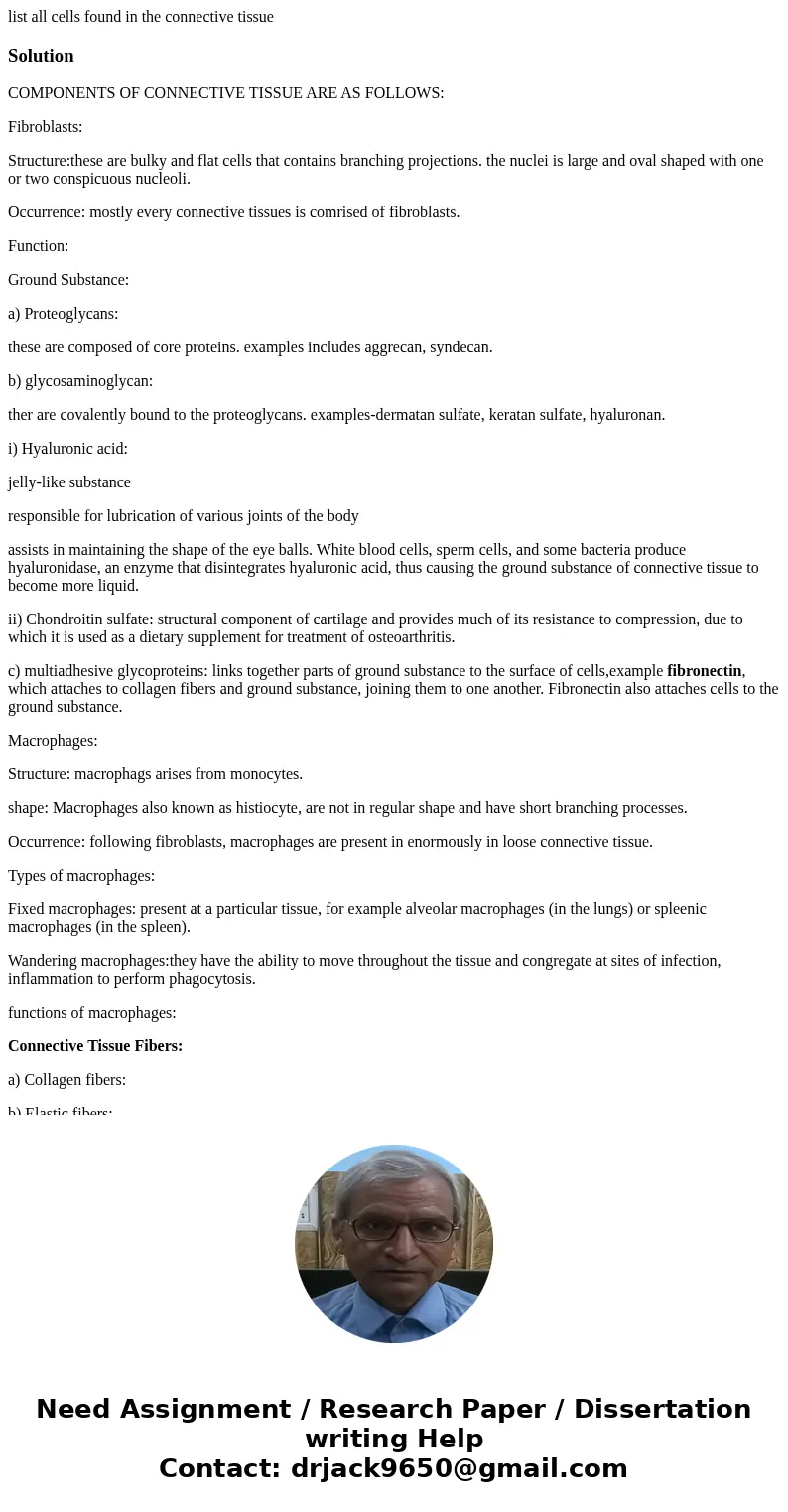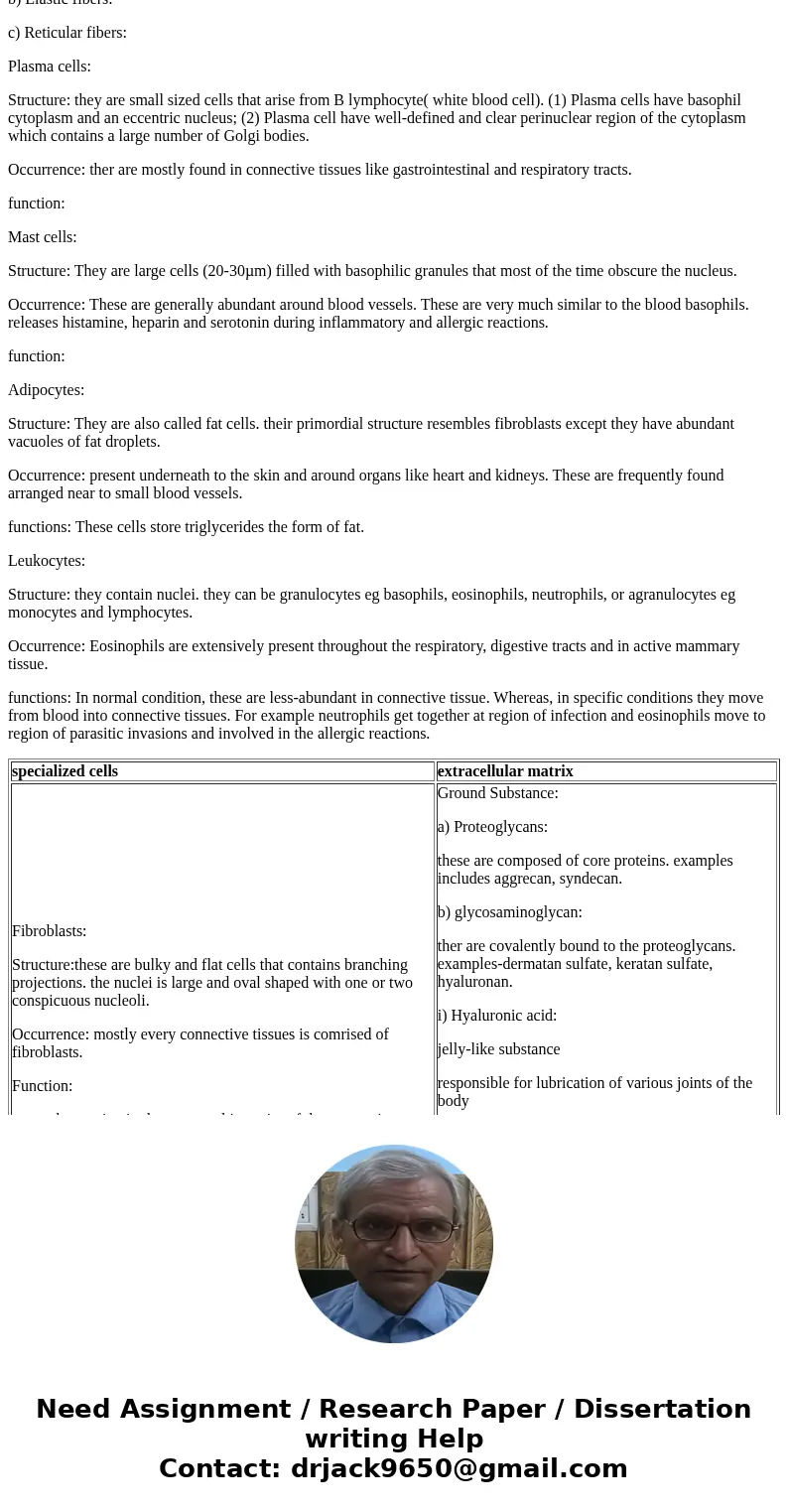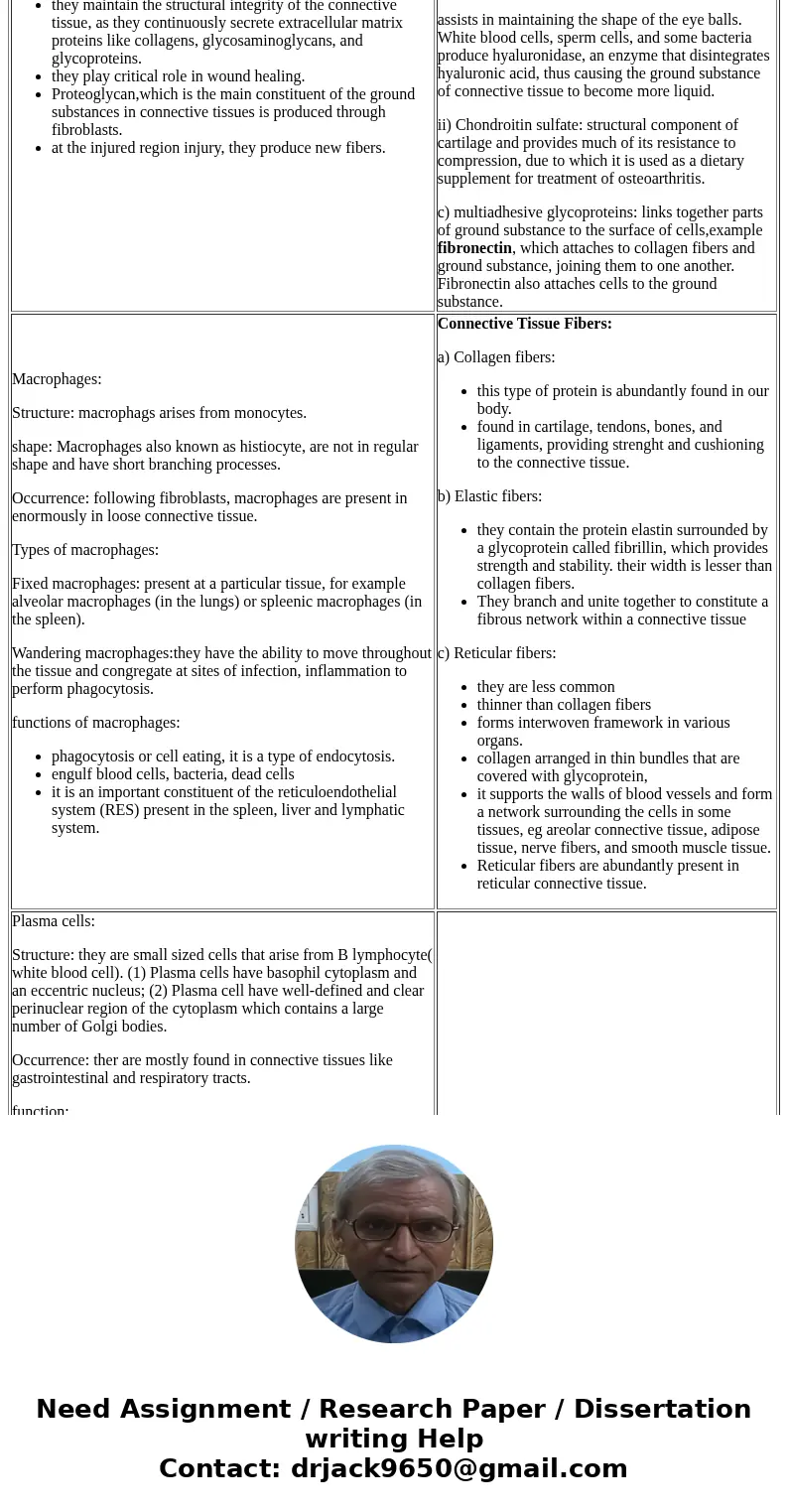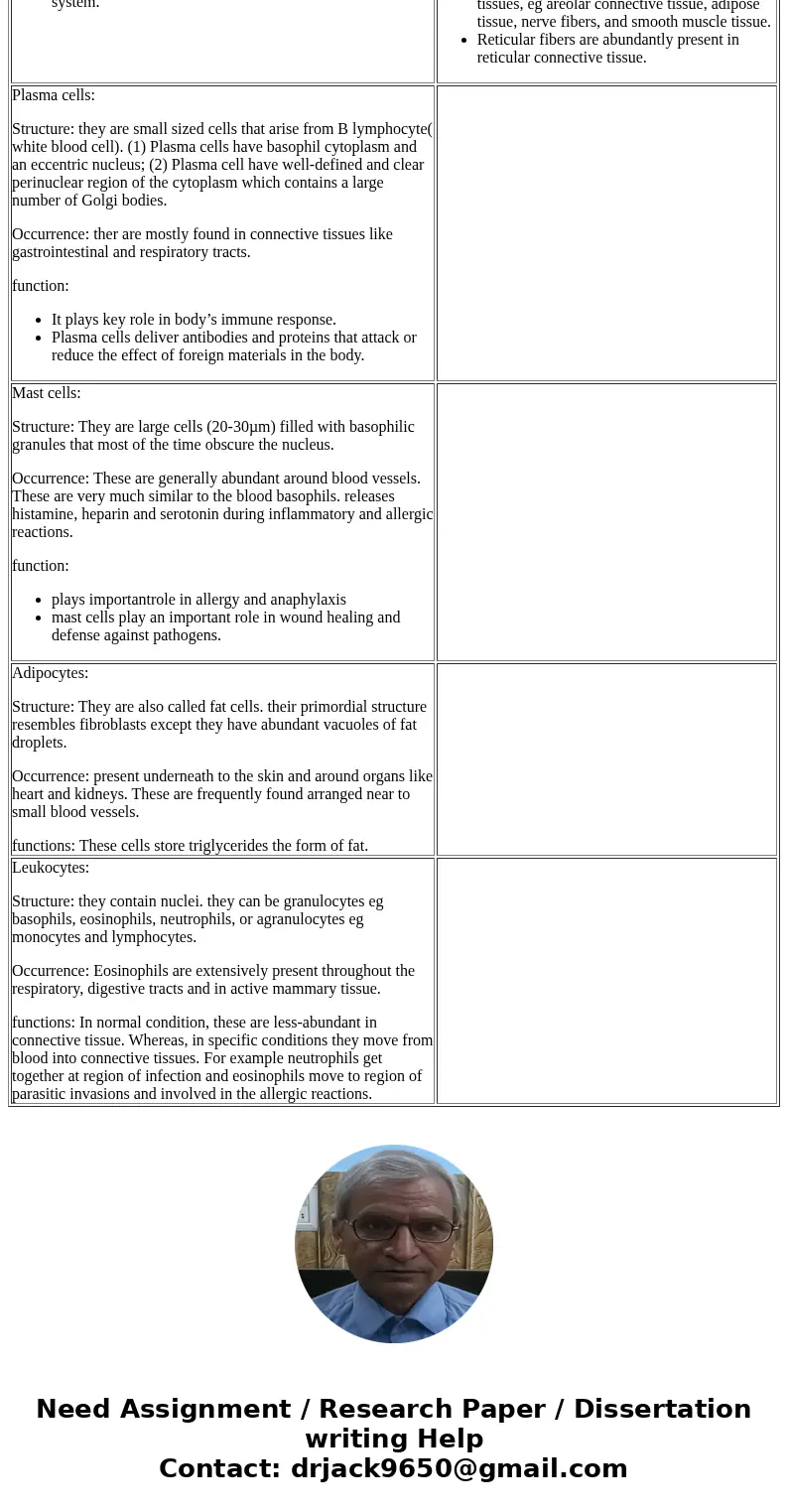list all cells found in the connective tissueSolutionCOMPONE
list all cells found in the connective tissue
Solution
COMPONENTS OF CONNECTIVE TISSUE ARE AS FOLLOWS:
Fibroblasts:
Structure:these are bulky and flat cells that contains branching projections. the nuclei is large and oval shaped with one or two conspicuous nucleoli.
Occurrence: mostly every connective tissues is comrised of fibroblasts.
Function:
Ground Substance:
a) Proteoglycans:
these are composed of core proteins. examples includes aggrecan, syndecan.
b) glycosaminoglycan:
ther are covalently bound to the proteoglycans. examples-dermatan sulfate, keratan sulfate, hyaluronan.
i) Hyaluronic acid:
jelly-like substance
responsible for lubrication of various joints of the body
assists in maintaining the shape of the eye balls. White blood cells, sperm cells, and some bacteria produce hyaluronidase, an enzyme that disintegrates hyaluronic acid, thus causing the ground substance of connective tissue to become more liquid.
ii) Chondroitin sulfate: structural component of cartilage and provides much of its resistance to compression, due to which it is used as a dietary supplement for treatment of osteoarthritis.
c) multiadhesive glycoproteins: links together parts of ground substance to the surface of cells,example fibronectin, which attaches to collagen fibers and ground substance, joining them to one another. Fibronectin also attaches cells to the ground substance.
Macrophages:
Structure: macrophags arises from monocytes.
shape: Macrophages also known as histiocyte, are not in regular shape and have short branching processes.
Occurrence: following fibroblasts, macrophages are present in enormously in loose connective tissue.
Types of macrophages:
Fixed macrophages: present at a particular tissue, for example alveolar macrophages (in the lungs) or spleenic macrophages (in the spleen).
Wandering macrophages:they have the ability to move throughout the tissue and congregate at sites of infection, inflammation to perform phagocytosis.
functions of macrophages:
Connective Tissue Fibers:
a) Collagen fibers:
b) Elastic fibers:
c) Reticular fibers:
Plasma cells:
Structure: they are small sized cells that arise from B lymphocyte( white blood cell). (1) Plasma cells have basophil cytoplasm and an eccentric nucleus; (2) Plasma cell have well-defined and clear perinuclear region of the cytoplasm which contains a large number of Golgi bodies.
Occurrence: ther are mostly found in connective tissues like gastrointestinal and respiratory tracts.
function:
Mast cells:
Structure: They are large cells (20-30µm) filled with basophilic granules that most of the time obscure the nucleus.
Occurrence: These are generally abundant around blood vessels. These are very much similar to the blood basophils. releases histamine, heparin and serotonin during inflammatory and allergic reactions.
function:
Adipocytes:
Structure: They are also called fat cells. their primordial structure resembles fibroblasts except they have abundant vacuoles of fat droplets.
Occurrence: present underneath to the skin and around organs like heart and kidneys. These are frequently found arranged near to small blood vessels.
functions: These cells store triglycerides the form of fat.
Leukocytes:
Structure: they contain nuclei. they can be granulocytes eg basophils, eosinophils, neutrophils, or agranulocytes eg monocytes and lymphocytes.
Occurrence: Eosinophils are extensively present throughout the respiratory, digestive tracts and in active mammary tissue.
functions: In normal condition, these are less-abundant in connective tissue. Whereas, in specific conditions they move from blood into connective tissues. For example neutrophils get together at region of infection and eosinophils move to region of parasitic invasions and involved in the allergic reactions.
| specialized cells | extracellular matrix |
| Fibroblasts: Structure:these are bulky and flat cells that contains branching projections. the nuclei is large and oval shaped with one or two conspicuous nucleoli. Occurrence: mostly every connective tissues is comrised of fibroblasts. Function:
| Ground Substance: a) Proteoglycans: these are composed of core proteins. examples includes aggrecan, syndecan. b) glycosaminoglycan: ther are covalently bound to the proteoglycans. examples-dermatan sulfate, keratan sulfate, hyaluronan. i) Hyaluronic acid: jelly-like substance responsible for lubrication of various joints of the body assists in maintaining the shape of the eye balls. White blood cells, sperm cells, and some bacteria produce hyaluronidase, an enzyme that disintegrates hyaluronic acid, thus causing the ground substance of connective tissue to become more liquid. ii) Chondroitin sulfate: structural component of cartilage and provides much of its resistance to compression, due to which it is used as a dietary supplement for treatment of osteoarthritis. c) multiadhesive glycoproteins: links together parts of ground substance to the surface of cells,example fibronectin, which attaches to collagen fibers and ground substance, joining them to one another. Fibronectin also attaches cells to the ground substance. |
| Macrophages: Structure: macrophags arises from monocytes. shape: Macrophages also known as histiocyte, are not in regular shape and have short branching processes. Occurrence: following fibroblasts, macrophages are present in enormously in loose connective tissue. Types of macrophages: Fixed macrophages: present at a particular tissue, for example alveolar macrophages (in the lungs) or spleenic macrophages (in the spleen). Wandering macrophages:they have the ability to move throughout the tissue and congregate at sites of infection, inflammation to perform phagocytosis. functions of macrophages:
| Connective Tissue Fibers: a) Collagen fibers:
b) Elastic fibers:
c) Reticular fibers:
|
| Plasma cells: Structure: they are small sized cells that arise from B lymphocyte( white blood cell). (1) Plasma cells have basophil cytoplasm and an eccentric nucleus; (2) Plasma cell have well-defined and clear perinuclear region of the cytoplasm which contains a large number of Golgi bodies. Occurrence: ther are mostly found in connective tissues like gastrointestinal and respiratory tracts. function:
| |
| Mast cells: Structure: They are large cells (20-30µm) filled with basophilic granules that most of the time obscure the nucleus. Occurrence: These are generally abundant around blood vessels. These are very much similar to the blood basophils. releases histamine, heparin and serotonin during inflammatory and allergic reactions. function:
| |
| Adipocytes: Structure: They are also called fat cells. their primordial structure resembles fibroblasts except they have abundant vacuoles of fat droplets. Occurrence: present underneath to the skin and around organs like heart and kidneys. These are frequently found arranged near to small blood vessels. functions: These cells store triglycerides the form of fat. | |
| Leukocytes: Structure: they contain nuclei. they can be granulocytes eg basophils, eosinophils, neutrophils, or agranulocytes eg monocytes and lymphocytes. Occurrence: Eosinophils are extensively present throughout the respiratory, digestive tracts and in active mammary tissue. functions: In normal condition, these are less-abundant in connective tissue. Whereas, in specific conditions they move from blood into connective tissues. For example neutrophils get together at region of infection and eosinophils move to region of parasitic invasions and involved in the allergic reactions. |




 Homework Sourse
Homework Sourse